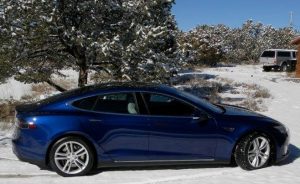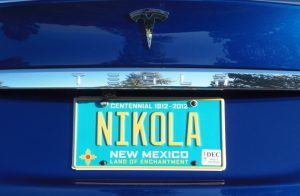Pati Nagle's Blog, page 3
June 26, 2017
The Tesla Diaries: 5. Range Anxiety
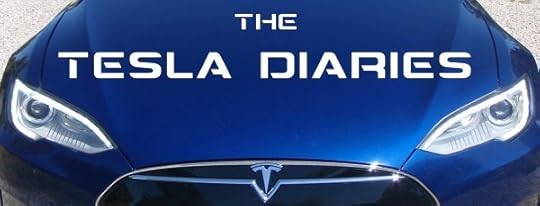
(This post is part of a blog series. In case you haven’t read it, here’s the first post.)
When you first get your Tesla, the touchscreen asks you to enter its name. We had entered Nikola, so having that for the plate made us that much happier.
It took a few weeks to get the hang of driving Nikola around town and on short trips in-state. We traded stories about our experiences every day: not only Tesla moments, but moments of discovery. “Did you know Nikola can do this?”
We joined the New Mexico Tesla Owners club (which is also open to interested non-owners), and had fun meeting other owners for group lunches and trading stories. It’s fun to see a dozen or more Teslas parked in a line together.
By the time the date arrived for our planned overnight trip to Winslow, Arizona, we were fairly comfortable driving the car … but this was different. We’d be going about 280 miles, more than our range on a single charge.
Range Anxiety reared its ugly head.
When you’re driving an ICE (internal combustion engine) car, you mostly don’t have range anxiety, because there are gas stations everywhere. If you happen to get careless and run out of gas, you can call for help or walk to a gas station.
Electric car owners are more susceptible to range anxiety, although they really don’t need to be. After all, there are even more electrical outlets than gas stations in the world. Regular house current is pretty slow, though. A 220 outlet or better is needed for anything more than a trickle of charge, and for a Tesla, the fastest available charge comes from a Tesla Supercharger.
At the time we got Nikola, there were three Supercharger stations in New Mexico: one in Albuquerque, one in Las Vegas (not on our route), and one in Gallup (on our route). The Albuquerque Supercharger wouldn’t be much help, because our battery would still be pretty full when we reached Albuquerque. So we’d have to charge in Gallup, 138 miles from Albuquerque.
In theory, our 85 kWh battery has a range of about 270 miles. In practice, it’s closer to 240 or 250. But running the heater cuts into that, and it was January. Also, if we used up all the battery charge, we could “brick” the car and end up stranded. Arranging towing for a 2.5-ton vehicle is a bit complicated, and while Tesla has mobile service available, the nearest source to us was in El Paso, 266 miles south of Albuquerque.
Now, the touchscreen has a navigation feature that helps you plan your drive to any destination. You tell it where you want to go, and it tells you where you need to stop and charge, and estimates how long it will take to charge enough to go the next leg. We knew this, but knowing something intellectually and understanding it viscerally are two different things.
The touchscreen also has an energy consumption feature, which guestimates your current range based on your most recent consumption. This estimate varies wildly, especially if you drive up and down mountain roads*. But we didn’t know that at the time, so it kind of freaked us out.
Long story short, we were nervous about running out of juice. We tiptoed out of Albuquerque at the speed limit. ICE cars zoomed past us.
Once we reached Gallup without trouble, we relaxed a bit. The Supercharger there is in the parking lot of a hotel, whose staff was friendly. We sat in their lobby, had coffee, and watched the news while the car was charging. After fifteen or twenty minutes, we figured we had enough charge to get to Winslow, or at least to Holbrook, where there’s another Supercharger, so we got back on the road.
Why didn’t we stay to top up the battery to a full charge? Because the closer a Tesla battery pack gets to being full, the slower it charges. It seems counter-intuitive, but the best strategy is actually to charge only as much as you need to get to the next Supercharger.
We continued to drive at a moderate speed, but we no longer felt as anxious about making it to Winslow. We kept an eye on the distance remaining and the charge remaining, dithering about whether to stop in Holbrook. Finally, we decided to skip it. We’d be pretty low when we got to Winslow, but we’d be charging overnight, so we’d have a full battery for the trip home.
I took the wheel for the last leg into Winslow. It’s a straight shot on westbound I-40. Nothing remarkable. Since we were feeling a bit more relaxed, I drove a little faster.
One thing we didn’t realize: the last few miles into Winslow coming from the east are uphill.
It was afternoon by now, and in the Southwest, days can get warm even in winter. We turned on the air conditioner to counter the hot sunlight.
Soon we noticed that our comfortable safety margin for getting to Winslow was decreasing. Yikes!
When your battery drops below 20%, your Tesla starts giving you range warnings. The green line on your mileage estimate graph turns yellow. The car suggests you find a place to charge soon. And if the charge drops low enough, the car starts shutting down “luxuries” like heating or air conditioning, and limiting your speed.
I dropped back down to the speed limit, and turned the thermostat up. The last mile or so into Winslow was a little tense, but really, we were in no trouble. Like many things about this new technology, we just needed to experience a low-charge situation to really understand it.
We reached La Posada with about 17% charge left. The hotel has two destination chargers. We plugged into one and unloaded our luggage, paused for a Tesla moment with some people in the parking lot, then went into the hotel and checked in.
On the way home the next day, we did better. Less anxiety, for sure. It was safest to drive at a moderate pace, which was actually relaxing. We have since found that to be true on all of our long distance trips. We let the ICE cars roar by if they want to, and take our time.
Now, all of this happened without Autopilot, because we had decided against buying it when we were designing the car. We apparently weren’t alone in that, because in May, we got a message from Tesla offering us a one-month free trial of Autopilot.
Want to taste the Koolaid? The first cup is free…
(To be continued…)
*Like many hybrids, Teslas have regenerative braking, which puts energy back into the battery when braking. This happens automatically when you are driving downhill with the cruise control set, for example. It can result in unrealistic range estimates on the energy consumption page.
June 19, 2017
The Tesla Diaries: 4. Adapting

(This post is part of a blog series. In case you haven’t read it, here’s the first post.)
Saturday morning, we woke to snow. We took photos of the truck (now banished from the garage) to advertise it for sale. We took a test run around the lower part of our driveway, which is a loop, to see how the Tesla did in about four inches of snow.
We were glad to be testing the car’s capability on the way out of our driveway rather than trying to get to the house. My spouse took the driver’s seat while I watched, ready to take emergency measures. With luck, the car would pack the snow down a bit so that the front-wheel drive Camry could get out. If the Tesla got stuck, the way would still not be blocked for the Camry to leave the driveway.
My spouse backed the Tesla out of the garage, navigated the uphill side of the loop, and swung around to the downhill side. It got through back up to the top, but slipped just a little at the deepest point. We decided not to push our luck, and put it back in the garage.
By the way—the wall-mounted Tesla charger in the garage plays this neat animation when it’s charging; a green light “drips” down the front of it to show that power is going into the car. The first of many fun discoveries we made.
We spent hours that weekend sitting in the car in the garage, poking through the options on the touch screen, learning our way around the controls. The entire Tesla owner’s manual, in electronic form, is accessible from this screen. Each driver’s fob is also the key to that driver’s profile, which includes all kinds of settings from seat and steering wheel position to configuration of the smaller dashboard display. We learned a lot, but we still had a lot to learn.
We continued our long discussions of what prestige plate to apply for. In our state, you list your top three choices and if you get one of them, you’re lucky. You won’t know until the plate arrives in the mail.
Some of the options we talked about, we later saw on other Teslas in New Mexico. We decided our first choice was “Nikola,” in honor of Nikola Tesla, the inventor of the electric motor that drives the car. We had seen this on plates from other states, but not on a New Mexico plate. Other options we considered included “Charged” and “Amped.”
On Sunday, the sun had melted the snow down a bit, and we decided to try taking the car out of the driveway. We took this photo at the bottom of the driveway:
We then held our breath as we headed up the steep gravel drive.
No problem.
Effortless.
The Model S is massive: two and a half tons. A third of that is the battery, which gives it a low center of mass and plenty of traction. As long as the snow isn’t so deep that the car high-centers on it, we can get in and out of our driveway.
It also corners like a dream.
A few days later, we took the car to Albuquerque to register it. That was the occasion of our first “Tesla moment.”
We did not coin that term. Probably someone on the Tesla forums did. It refers to a moment when a Tesla owner interacts with a stranger about the car, usually when that person shows interest or appreciation. There’s a whole board on the Tesla forums devoted to Tesla moments.
Ours happened at the Motor Vehicle Division, when we were registering the car. The clerk who handled our application made an appreciative comment about how pretty it was. (Apparently she was able to bring up a picture by accessing our VIN—complete with Deep Blue Metallic.) We had a nice chat with her about how great the car was, paid the registration fees and submitted our list of prestige plate choices, and left feeling happily bemused, with fingers crossed for getting our top pick.
Tesla moments do not get old. At least, for us they haven’t. Each one is different, and they’re always fun. They’re part of our job as ambassadors for the electric car. Whenever either of us has been driving the car, we report on any Tesla moments we had.
Monday came around. Snow was melting off, and it was time for the spouse to head to work. He took the Tesla, smiling all the way, I’m sure. Since I work at home, we decided he would drive the car whenever I didn’t need it for errands or meetings. The Tesla costs less to drive than the Camry, so it makes sense for us to be putting most of our mileage on that car.
Gradually, we spread our wings a little more. The next weekend we drove the car all the way to Santa Fe, to meet my siblings for lunch.
On a long, straight stretch of state highway, I suggested that my spouse (who was driving), do something I did on my test drive, which he hadn’t had the opportunity to do on his. He came to a complete stop, making sure no other cars were around, then floored it.
The first word out of his mouth was unprintable.
The next thing he said was, “My eyes!” because the “launch” had pressed them back in his skull.
Our car actually has something called “Launch Mode.” (Not Ludicrous Mode—that’s a part of the power package option, which we didn’t get.) Launch Mode gives you just a bit of a boost during a cold start, to up the zero-to-sixty speed. We have never turned it on. The car is scary enough without it.
On that drive we also started to learn about the differences between the car’s estimated range available and the actual range we would get out of it. Things like using the heater (and, um, “launching”) drain power from the battery, affecting the range (more on that later).
We were learning new things about the car every day. We planned an overnight trip for a weekend in January, to test the range capability. We have a favorite historic hotel along I-40 west of Albuquerque: La Posada in Winslow, Arizona. On a normal road trip, we stop there for lunch in the amazing Turquoise Room. On this trip, we planned to stay overnight and drive home the next day, partly because La Posada has a “destination charger.”
This is the exact same kind of charger we have in our garage. When there’s one at a hotel, restaurant, or other public-access place, it’s called a destination charger. They show up on the GPS display on the Tesla touchscreen, so as you’re driving along you can find the nearest charger. You can also look them up on the Tesla website under “Charging.” You can display Tesla Superchargers the same way. More on that later.
It was holiday season, and we had given ourselves the best present ever. We took it to the Albuquerque Supercharger, just to see how that worked. We took it to a friend’s holiday party, and had a group Tesla moment with several of the guests. We ended up taking them for rides around the block, demonstrating the “launch.” We went to another friend’s holiday party and did it again. And then again.
At the third holiday party, one of the people we invited to sit in the car sat staring at the displays, and said, “I feel like I’m sitting in the future.”
Yes, my friend. You were. This car—this Magical Space Car—is real, and it’s the future.
I don’t remember exactly when, but somewhere around the holidays, we got a big, flat envelope from the Motor Vehicle Division. My spouse snuck it out of the house, and then invited me to come look at the car, which he had parked in the driveway.
(To be continued…)
June 12, 2017
The Tesla Diaries: 3. Anticipation

(This post is part of a blog series. In case you haven’t read it, here’s the first post.)
The first thing Tesla did when we placed our order was inform us they were giving us a few days to change our mind.
Really, that was smart of them. In the heat of the moment, rash decisions are possible. Buyer’s regret on a high-end luxury car is a serious issue.
We had no regrets. We’d already done a lot of should-we-shouldn’t-we. And there was Deep Blue.
After the cool-down period, Tesla billed our credit card for the down-payment and started sending us emails. “The parts to build your car have been ordered.” “The parts to build your car have been shipped to the factory.” Each one a little tease, a little reminder that they hadn’t forgotten, a little suggestion that we not pester them about when we’d get our car. We estimated mid-December, and tried to go about our normal lives without doing too much Snoopy-dancing. Meanwhile, we fretted about how the car would be delivered.
Tesla does not have a showroom in our state, because our state has a law that prohibits it. The law was pushed through by dealerships in the 1990s, ostensibly to protect them from abuse by manufacturers. Basically, the law requires that any sales of automobiles at a business in New Mexico must go through a dealership—a middle-man.
But Tesla does not use the dealership model. It sells directly to the customer (see Design Studio discussion in the previous post).
Note that this law does not prevent us from buying a Tesla. It merely prevents Tesla from having a showroom in New Mexico. We ordered our car online. That’s how it’s done. The lack of a Tesla showroom in our state simply meant that there wasn’t a place for us to pick up our car (and be showered with swag). We had a two choices: travel to a showroom in a neighboring state (over 400 miles away), or accept delivery from a transport truck. We opted for the latter.
We live in a rural mountain area, with windy, twisty roads. Our driveway is long and steep. Not a good place for a big automobile transport. So we had long discussions about where we should meet the truck. At a nearby community center? At a pullout on the nearest highway? We decided on a not-so-nearby civic building with a big adjacent parking lot, still closer to our house than Albuquerque.
Thanksgiving went by. We tried not to grumble about vacation days. Then, on November 30, we got an email:
“Your Model S Has Entered Production.”

Then, a week later, our friendly “Tesla Ownership Advisor” (concierge) started sending paperwork: “Here’s your purchase agreement.” “These are your payment arrangements. And oh, if you haven’t watched the walk-through videos, please do.”
And he started talking about scheduling delivery. We told him about the place we had carefully picked out for accepting the car, and they said they’d inform the driver of the truck.
The truck that would have our car on it. Our Magical Space Car!
The driver (who was still in California) called and said, “I have a car for you.” He would be arriving late Friday, and would bring the car to our planned meeting place on Saturday morning.
And then we saw the weather forecast. Snow on Saturday.
Snow is rarely a big deal in Albuquerque, but we live in the mountains. We were concerned about driving our brand new car home in a possible blizzard. We asked the driver if we could get the car early because of the expected storm. He suggested we meet him at his hotel.
Friday evening found us on the west side of Albuquerque, at a cluster of modest hotels on a cul-de-sac, awaiting the arrival of our car. We were like kids on Christmas Eve. Every time a truck came down the street, we thought it might be ours. Every time it wasn’t, we were disappointed.
At last, an unmarked, smooth-sided semi drove in, turned around in the dirt lot at the end of the cul-de-sac, and parked in front of the correct hotel. It was the kind of truck race-cars get transported in.
We got out of the Camry and walked across the street to greet the driver. He took one look at us and grinned. “Excited about this car, are you?”
He must have seen that a lot. If we were kids at Christmas, this guy got to be Santa Claus all the time.
I wish I had thought to bring a camera. It would have been cool to have pictures of our car being unloaded. It was dark, though.
The driver, who hadn’t even checked into his hotel, spent the next twenty minutes unloading the car, removing protective plastic, wiping it down with towels, and making sure everything was in order. We watched our car emerge like a newborn. The process was fascinating.
Finally he asked us to sign for it, and handed us the fobs. Tesla fobs are shaped like a miniature Tesla. They’re smooth and slippery. I held onto mine tightly.
This beautiful, deep blue car belonged to us.
We thanked the driver and headed home. I had the honor of driving the Tesla. Though I’d taken a test drive, this was different. I now had the responsibility of driving this car about forty miles, on city streets, a freeway, highways, and mountain roads, at night, to our home.
I was a little nervous.
Teslas are silent. There’s no engine, nothing to rumble. I glided slowly out of the cul-de-sac, my spouse following in the Camry. He probably laughed at me a lot on our way home.
Because of the way the streets were organized in that area, I had to turn right out of the cul-de-sac, then find a place to turn around. I missed the first opportunity, it being night and an unfamiliar area. Finally I found a turn-around and got going toward the freeway.
It was probably the slowest, most timid driving ever done in a powerful sports car.
Once on the freeway I began to relax. The job was simpler here. Just stay between the lines and drive at an appropriate speed. There were about fifteen miles, with only one interchange, between me and the exit to the next highway.
A Tesla is different from an ICE car (ICE = Internal Combustion Engine) in many subtle ways. There are the usual differences between different makes of cars. The cruise control is on the opposite side of the steering column from the Camry’s, for instance. But the Tesla/non-Tesla differences go deeper.
A big one is the touch screen. It controls a lot of functions, like the radio and climate control. It also displays a live GPS map while you’re driving, and you can program in a destination and have it show you the route.
I did not do this. I was still getting used to where things like the cruise control were. But I did, after about ten miles, have a revelation about just how different this car was.
I had entered Tijeras Canyon, where I-40 passes between the Sandia and Manzano Mountains. Parts of it are long and steep, and it’s a workout for semi trucks and low-powered vehicles.
I was passing a semi, and decided I’d like to go just a little faster so as to clear it more quickly. Maybe five miles an hour faster.
I looked at the speedometer, and I was already going five miles faster.
My car was psychic.
Actually, my car was just very responsive. The tiniest pressure on the accelerator was enough to increase my speed 5 mph, even going uphill.
You know how you can feel an ICE car working when you’re going up a steep hill? Maybe the engine makes a bit more noise, maybe you downshift? You press harder on the accelerator, and you kind of lean forward a little, as if you can help the car by doing that?
Doesn’t happen in the Tesla. That car goes up any hill with no sensation of laboring. It’s not just powerful.
It’s effortless.
(To be continued…)
June 4, 2017
The Tesla Diaries: 2. The Plunge

(This post is part of a blog series. In case you haven’t read it, here’s the first post.)
We now got serious about the design studio. We had long discussions about which options we had to have (“D” package, AKA all-wheel drive, because snow; light-colored interior, because sun; Deep Blue Metallic, because duh) and which we could live without (deluxe sound system, power package, special effects lighting).
We looked at the Autopilot option, scratched our heads because we didn’t really understand it, and decided against it. We wanted to be in control of the car, thanks. That’s why we liked manual transmissions.
This turned out to be a bad decision. More on that later.
We saw that Tesla was offering the 85 kilowatt-hour (kWh) battery pack for a mere $5k more than the 70 kWh pack.
>>>MATH ALERT!<<<
85 kWh = about 275 miles of range
70 kWh = about 235 miles of range
Difference = about 40 miles of range
Going up to the 90 kWh pack (about 295 miles of range) would add another $5k to the cost. That’s $5k more for an extra 20 miles of range. We decided to go with the 85.
Why not the 70? Because we wanted to be able to drive into Albuquerque, pick up friends, drive to Santa Fe and party around, then drive our friends home and get back to our own home all on one charge. A range of 235 miles would be cutting it too close for comfort. The 275 mile range would allow a more reasonable safety margin.
This was our first taste of Range Anxiety. More on that later.
By the way, neither the 70 kWh nor the 85 kWh battery pack is available on the Model S now. Ever on the watch for higher efficiency, Tesla is streamlining its options. (The current Model S battery options are 75 kWh, 90 kWh, and 100 kWh. Rumor has it the 90k will soon be phased out. The smaller Model 3 coming out in July 2017 is expected to offer 60 kWh up to 75 kWh batteries.)
As a nod to luxury, and a consolation prize for not getting the really cool but totally frivolous lighting package (light-up door handles!), we added a sunroof.
Bottom line with the options we wanted: $89,000.
We would get a federal tax credit for buying an electric car. That would knock $7,500 off the price. Still, ouch.
We took a hard look at our finances. We had a loan on the Camry, and we had a pickup that was paid off. Selling the truck (sob) would give us enough to pay off the Camry, leaving us with only the Model S to pay for.
I had some inheritance money, earmarked for retirement, but I was willing to put part of it toward a down-payment. I also had a sale coming up for the first book in my most popular novel series. I decided that if that sale generated a certain amount of income, I’d be willing to put the money toward a Tesla, and match the amount from my inheritance. That would bring us up to about half the cost of the Model S. My spouse agreed that if all that fell into place, he would be willing to make the payments on a loan for the balance.
This was not a trivial decision. We had never, ever imagined spending anything near this amount on a car.
But we weren’t just buying a car. We were investing in the future. Part of the money we were spending would go toward the development of the Model 3, that more-affordable car that had first sparked our interest. Part of the money would go toward expanding the network of Tesla Superchargers (high-speed chargers spaced along major roads, designed to facilitate long-distance driving). And as owners of a Model S, we’d be entitled to use those Superchargers for free, forever.*
That’s the thing about buying a Tesla. The cost looks scary. But it’s all up front.
After you buy the car, your fuel costs drop to about a third of what they were. Your maintenance costs are almost nil. No oil changes, no spark plugs, hoses, etc. No muffler, no transmission. The Tesla has very few moving parts.
Keeping our lovely Camry going was costing us about $1200/year in maintenance and another $2000 in fuel costs. So that’s about $3200 per year in additional cost. By 2015, the Camry we’d paid $28k for had now cost us over $34k. (We still own it today, though we’re driving it a lot less. In 2017, the total cost is up to about $38k, coming up on half the cost of our dream Model S.)
Yes, electricity to charge a Tesla costs something, but not nearly as much as gasoline. If you do all your charging at the Supercharger (which is not only inconvenient but lame), it might be free*. Or, to quote Matthew Inman (creator of The Oatmeal) again, your car might be powered by the motherfreakin’ sun. More on that later.
My book promotion went live in October of 2015. It did very well, so that within about ten days, it had generated the target amount I had decided on.
We drank champagne. My spouse got pre-approval for a loan in the amount we had planned for. We put the truck up for sale. We ordered a dedicated charger for our garage, and had it installed. (This wasn’t strictly necessary; you can charge a Tesla using its included cable and a dryer socket, but a dedicated Tesla charger is more convenient.)
Then in mid-November, we went online to the Tesla Design Studio, entered our credit card number for the minimum down payment, and clicked the “Place Order” button.
Our lives would never be the same.
(To be continued…)
*The free-forever deal was discontinued after January 2017, then reinstated for Model S and Model X owners in May 2017, but new car purchasers can only get it by using a referral code from an existing Tesla owner, like this one: http://ts.la/chris7110 (good for five referrals, after which it expires). This offer ends in December 2017.
May 28, 2017
The Tesla Diaries: 1. Dreaming

When I first became aware of the existence of Tesla Motors and their goal of making electric cars that everyone could afford, I went out and bought some Tesla stock. I did that because I couldn’t afford to buy a Tesla car, but I was super-excited about the idea and wanted to support it.
That was in June of 2013, about a month after Consumer Reports rated the Tesla Model S the best car ever tested. That’s probably what put the company on my radar. Too bad I didn’t get in before the stock price tripled right after the Consumer Reports announcement.
This story is about the car, though—not about the stock.
That summer my spouse and I began to dream about owning an electric car. The Model S was beyond our reach; the price tag well outside our comfort zone. Who besides the incredibly wealthy could spend $100k on a car? I’d lived in houses that cost a lot less.
Our dreams were pinned on the promise of a less expensive Tesla down the road. Elon Musk’s plan was to build a ridiculously expensive sports car (the Roadster), use the proceeds from that to create a slightly less expensive luxury sports car (the Model S), and use funds from that to eventually build a car that people who weren’t incredibly wealthy could at least aspire to own. It would take a few years to get there.
From the time we first learned about Tesla, we were thrilled at the idea of owning an all-electric car. It would be a step toward cleaner energy. Even if the electricity it used was created by burning fossil fuels, the car would have less impact on the environment than a gas-powered car, and would be much safer. (As Matthew Inman of The Oatmeal points out in his wonderfully profane blog post about Tesla cars, the level of a driver’s happiness increases in direct proportion to the distance of explosions from the driver’s crotch.)
In fact, that best-ever rating for the Model S included the fact that it was the safest car ever tested. That had huge appeal for us.
The other thing about the Tesla Model S was that it offered over 200 miles of range. Living where we live, in rural New Mexico, that was essential. My spouse’s commute is a 70-mile round-trip. No electric car that we’d heard of had enough range for that, until the advent of the Model S.
We had friends who owned hybrids. We looked into that less-expensive solution, but for us, it wasn’t worthwhile. Again, range was the issue. A hybrid car is designed to operate efficiently in city traffic. Most of our driving, including my spouse’s commute, involves a lot of highway miles. So we’d just be burning gas to haul around an electric motor most of the time. Not efficient.
We watched the news about Tesla, while the company and Elon Musk accumulated a bunch of awards. We watched the stock price swing wildly (but we had been in an investment club and learned about long-term investing, so we weren’t freaked out). We watched, we waited, and we dreamed.
On the Tesla website, there’s a page where you can configure your dream car: the Design Studio. No obligation, no commitment. You don’t even have to cough up an email address. We spent a lot of time on that page, playing with our dream car, adding and subtracting options and seeing what that did to the bottom line. The price remained ridiculously high, but it was fun to play and to dream.
In August of 2013, we needed to replace my spouse’s commuter car. Alas, we had not won the lottery, so a Model S was out of the question. Instead, we bought a brand-new Camry LE, on which we spent the breathtaking sum of about $28k.
That felt so extravagant. The car had luxury features we’d never enjoyed before: built-in GPS, a rear-view camera for reverse (soon to be required equipment, but a luxury then), a sun roof, satellite radio. We were really spoiling ourselves. What we didn’t realize was that we were practicing to become Tesla owners. The Camry was an incremental step toward our dream car.
While we were getting accustomed to driving a really comfortable, nicely quiet, reasonably powerful car, we continued to play with Tesla’s design studio. We traveled long distances to take test drives in the Tesla Model S, and were blown away by its silence and its power.
Fast-forward a couple of years to the summer of 2015, when two things happened: one of my novel series started to generate more income than I had ever earned before, and Tesla Motors brought out a new color for the Model S: Deep Blue Metallic.
Don’t laugh. When you’re shopping for a car, color is important, even though it’s probably the most likely option to go out the window for the sake of compromise. There are certain colors that are deal-breakers for me. I won’t buy a car that color, period.
For example, my spouse and I refuse to own a car with a black interior. Why? We live in the Southwest. Cars get really hot, really fast in the summer. A black interior absorbs a lot of heat.
When we were shopping for the Camry, we wanted a manual transmission (which we’ve always preferred), but the only cars that had them in our area all had black interiors. So we compromised. The Camry had an automatic transmission, but at least the interior was a light color. We also had to compromise on the exterior color, accepting a gray one when we would have preferred a different color that wasn’t on the lot with the options we wanted.
See, with Tesla’s design studio, that never happens.
When you buy a car from Tesla, you design it yourself. Battery size, sound system, interior, and all other options including color.
And then when you commit to buying that particular configuration, they build it for you.
Think about that.
No more wandering around a dealership lot looking at stickers, hunting for the features you want. No more salespeople pressuring you. No more haggling. No more compromise.
You design the car you want, and then they build that exact car.
No wonder the traditional automobile industry is terrified of Tesla Motors.
So, anyway, Tesla brought out Deep Blue Metallic for the Model S. And we said, “Ooooohhhhh.”
This was the color we wanted. Other available colors were black, red, white, champagne. There had been a color called Dark Blue, which was such a dark navy that it looked black in all but the brightest sunlight. We didn’t care for that.
But Deep Blue was a delicious, jewel-tone blue. And it tipped the scales.
We went from dreaming about owning a Tesla to knowing we must have one. And it had to be Deep Blue.
(To be continued…)
February 13, 2017
Some Really Incredibly Wonderful Photos of Maine Coons
As you know, folks, Leon in Pet Noir is a genetically-modified Maine Coon. While these cats can’t talk, they’re every bit as amazing-looking as Leon.
Hat-tip to Walking Raven on Facebook for the link.
November 16, 2016
The ælven are back…
Book 1 of the Blood of the Kindred series is back in a new edition, with a new title. This book was originally published with the title, The Betrayal. Have you heard me complaining about how many books are out there with that title? Trust me, it’s a lot. Or find out yourself by doing a search on the title in your favorite online bookstore.
Then search on “Blood of the Kindred.”
My brother recently asked me if this book has vampires. Well, since it’s an alternative origin story for vampires, yes it does. But the book is about social conflict, not about gore. There’s not a lot of violence (although there is some).
Nor do these vampires sparkle. They are actually elves whose future took a dark turn. (That may resonate right now….)
If you like fantasy, elves, Tolkien, female characters who do more than flutter their eyelashes, and stories of hope in spite of all, this book may be for you. Check out the free sample.
 Blood of the Kindred series, Book 1
Blood of the Kindred series, Book 1ebook $5.99
paperback $16.99
292 pages
The immortal ælven were forever divided when one clan began a forbidden practice: the drinking of blood.
Clan Darkshore was cast out of the ælven, named “alben,” and driven west of the mountains into exile, their protests—that they must drink blood or perish—ignored. Centuries later, Darkshore’s leader, Shalár, burns with anger at the memory of the war against her clan, and weaves a plan to reclaim her former home and make the ælven accept the truth about her people.
East of the mountains, a young ælven, Eliani, takes up the sword after her lover betrays her. She has no use for the elegant, much-admired Turisan, heir to the governor of a neighboring realm, but when they find evidence that the alben may again be hunting in ælven realms, they become uneasy allies.
With the threat of the alben’s return driving the ælven to prepare for war, Eliani and Turisan discover that they share mindspeech. This rare gift could be the salvation of their people—if Turisan can persuade Eliani to permit the intimacy of his mental touch.
Download an Ebook Sample: EPUB ~ MOBI
Buy the book:
ebook at Book View Café <<< Why this bookseller? Because the author receives the highest share of the cover price here.
paperback at Createspace <<< Why this bookseller? Because the author receives the highest share of the cover price here.
Or buy at your favorite bookstore!
Originally published as The Betrayal by Del Rey Books
May 19, 2016
Now in Paperback and Ebook: FINAL TABLE
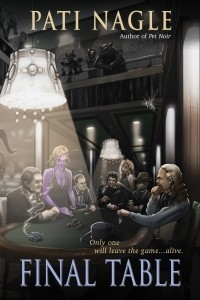 Only one will leave the game…alive.
Only one will leave the game…alive.
Wild Bill Hickok, alive again in the graveyard in Deadwood on a cold October night, has an irresistible compulsion to go to Atlantic City. There, in the mysterious and magical Black Queen casino, he joins a rogue’s gallery of resurrected scoundrels, all gamblers who were murdered like himself.
Will the father of organized crime revert to his bad habits and attempt to take over the Queen? Will Wild Bill finally find out if those aces and eights are winners? Five murdered men sit down to a poker tournament for the highest possible stakes: the right to stay alive.
January 25, 2016
Why I Don’t Go to the Movies Any More (and What Would Bring Me Back)
 I love movies, but I don’t go to the movie theater much any more. I can’t enjoy films there like I used to. Why?
I love movies, but I don’t go to the movie theater much any more. I can’t enjoy films there like I used to. Why?
I have partial hearing loss, in a specific way that makes it hard for me to understand what people are saying. My weakest frequencies are those where the consonants in speech occur, so to me it sounds like everyone is mumbling.
I have hearing aids. They help, but I still miss a lot. They are also uncomfortable (a different issue that I’ll pass over today).
Even with the hearing aids, I have to concentrate, hard, just to participate in a conversation, and I do a lot of guessing anyway. Add to that the additional sounds in a movie soundtrack–music (often too loud) and sound effects–and I miss out on a lot of the dialogue. So I prefer to watch movies at home, where I can turn on the captions.
Movie theaters sometimes have helpful devices that can be borrowed by the “hearing impaired.” The most common of these are headphones. Thanks, but all that does is amplify the mishmosh and give me a headache (see “I have hearing aids” above).
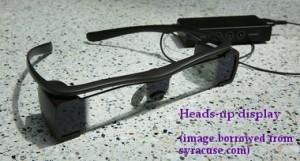 A more helpful device is a gadget that displays captions for the movie. I’ve tried two kinds – one is a high-tech visor thingie that projects a heads-up display of closed captions. Pretty good, but there’s no control over where the captions appear, and I had to hold my head at a fatiguing angle to see both them and the movie. Also, they’re kind of heavy, so…headache. And I suspect they’re expensive; I’ve only been offered them at one theater and they held my driver’s license hostage while I was using them.
A more helpful device is a gadget that displays captions for the movie. I’ve tried two kinds – one is a high-tech visor thingie that projects a heads-up display of closed captions. Pretty good, but there’s no control over where the captions appear, and I had to hold my head at a fatiguing angle to see both them and the movie. Also, they’re kind of heavy, so…headache. And I suspect they’re expensive; I’ve only been offered them at one theater and they held my driver’s license hostage while I was using them.
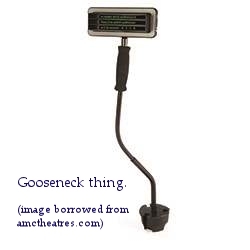 The other gadget I’ve tried is a low-tech dot-matrix display (like on traffic message signs) on a gooseneck attached to a weight that plugs into a cup holder. The gooseneck can be used to position the display comfortably. Unfortunately this can lead to the thing falling out of the cup-holder.
The other gadget I’ve tried is a low-tech dot-matrix display (like on traffic message signs) on a gooseneck attached to a weight that plugs into a cup holder. The gooseneck can be used to position the display comfortably. Unfortunately this can lead to the thing falling out of the cup-holder.
Both these gizmos are OK, if slightly inconvenient, but I’ve found that the majority of the time, they’re not available. This may change, according to this article in the Los Angeles Times, but theater owners don’t like the potential cost. AMC is apparently going to make the gooseneck thing available in all their theatres.
But maybe there’s an easier way.
I have this high-tech electronic device that I paid for with my own money. It’s called a tablet. If it could receive a broadcast of closed-captioning, I’d be happy to bring it with me to the movie theater. I could put it on a little gooseneck or telescoping handle of my own, tune it in to the correct movie broadcast, and voila. Inexpensive for the theater, convenient for me. They could keep a couple of loaner tablets on hand for people who don’t own one. Way cheaper than the high-tech headache-inducing headsets, or the heavy gooseneck cupholder things.
So I’m tossing this idea out into the ether, for any techie who might feel like picking up on it and making it real. You don’t have to pay me a cent. Just make it happen, OK?
October 22, 2015
Meditations on Molding Sugar Skulls
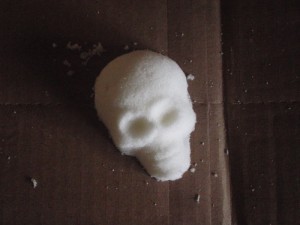 It’s mid-October, one of my favorite times of year, and I’m preparing for my annual sugar skull decorating party. It’s a fun activity, and also a tribute to those who have passed on. Every year guests honor loved ones, relatives, dear friends, beloved pets – even a popular character from a TV series.
It’s mid-October, one of my favorite times of year, and I’m preparing for my annual sugar skull decorating party. It’s a fun activity, and also a tribute to those who have passed on. Every year guests honor loved ones, relatives, dear friends, beloved pets – even a popular character from a TV series.
So I am in my kitchen with a ten-pound bag of sugar, a jar of meringue powder, a skull mold and a bunch of cardboard, ready to make the skulls. It’s a little tedious, but as I measure cup after cup of sugar into my largest mixing bowl, I think about the skulls and what they mean, and the happiness they promise. This tradition is not morbid; it’s joyful. It’s remembering with fondness those who are no longer with us.
I had a conversation with one of this year’s guests about whether or not to serve sweets at the party. I tend to avoid it, because there’s so much sugar present as it is. Not that anyone eats the skulls; they’re edible, but it’s essentially a giant lump of sugar, and most of us are past the age when that sounds delicious. But just handling them seems to impart a bit of a sugar high.
In fact, as I stir the meringue powder and sugar, I realize I’m inhaling a fair quantity of sucrose just from what’s in the air. I put a stop to that by adding the small amount of water needed to bind the sugar into a moldable state.
My recipe says the mixture should feel like slightly damp sand, not wet, but damp enough to hold its shape if you squeeze a handful. As I knead in the water, making sure there are no soggy lumps, I think of walking on a beach as the tide goes out. Firm, damp sand underfoot. One could make a sugar castle, I suppose.
The sand simile is appropriate. Like sand, the sugar gets everywhere. On the counters, on the floor, on my clothes. The kitchen will need several wipedowns, sweepings, and at least one mopping before it’s back to normal.
 With the sugar mixture just damp enough, I start molding the skulls. Scoop up a handful, press into the mold, brush off the excess, flip onto the plastic card (which I made years ago after going through too many index cards), and slide onto the cardboard. Repeat many times. The cat watches from the sideboard, no doubt wondering what the crazy human is up to now.
With the sugar mixture just damp enough, I start molding the skulls. Scoop up a handful, press into the mold, brush off the excess, flip onto the plastic card (which I made years ago after going through too many index cards), and slide onto the cardboard. Repeat many times. The cat watches from the sideboard, no doubt wondering what the crazy human is up to now.
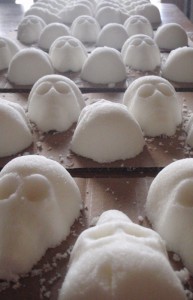 When all the sugar is gone, there are sixty skulls. That’s probably enough. Most guests decorate at least two; some do four or even six.
When all the sugar is gone, there are sixty skulls. That’s probably enough. Most guests decorate at least two; some do four or even six.
The skulls must dry for a day or so, and then I’ll get out the paints and sequins and feathers and glue and whatnot, and we’ll make a grand mess and have wonderful fun.
But until then they are pristine; they are merely a promise.
I guess they’re a little ghostly after all.

